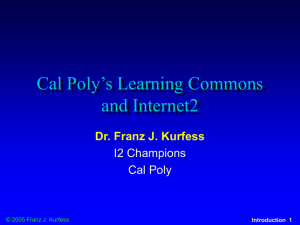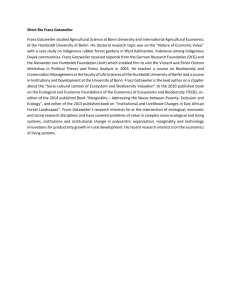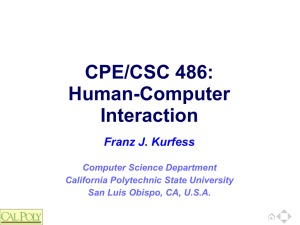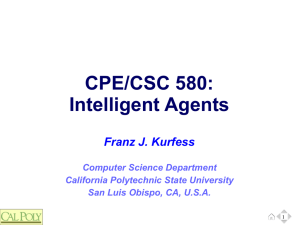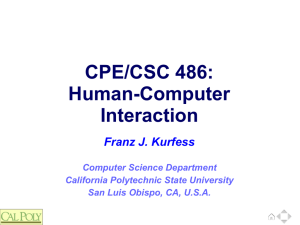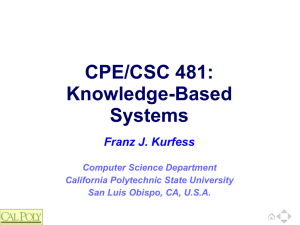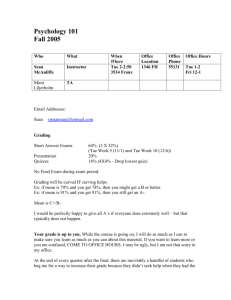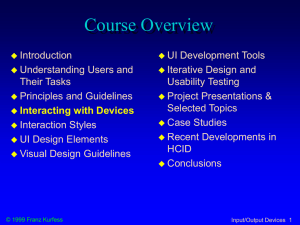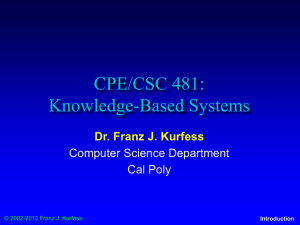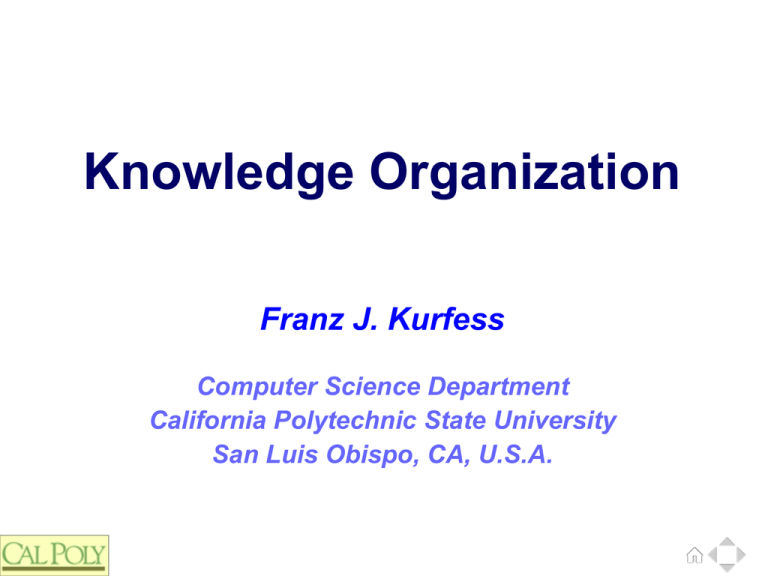
Knowledge Organization
Franz J. Kurfess
Computer Science Department
California Polytechnic State University
San Luis Obispo, CA, U.S.A.
Acknowledgements
Some of the material in these slides was developed for a
lecture series sponsored by the European Community
under the BPD program
with Vilnius University
as host institution
Overview Knowledge
Organization
Motivation, Objectives
❖ Chapter Introduction
❖
❖
❖
New topics,Terminology
Identification of Knowledge
Object Selection
❖ Naming and Description
❖
❖
Categorization
Feature-based Categorization
❖ Hierarchical Categorization
❖
❖
Knowledge Organization Methods
Natural Language
❖ Ontologies
❖
❖
Franz Kurfess: Knowledge Organization
Knowledge Organization
Tools
6
Motivation and
Objectives
10
Motivation
❖
effective utilization of knowledge depends
critically on its organization
quick access
❖ identification of relevant knowledge
❖ assessment of available knowledge
❖
source, reliability, applicability
❖
❖
knowledge organization is a difficult task, and
requires complementary skills
expertise in the domain
❖ knowledge organization skills
❖
librarians
❖
Franz Kurfess: Knowledge Organization
11
Objectives
be able to identify the main aspects dealing with
the organization of knowledge
❖ understand knowledge organization methods
❖ apply the capabilities of computers to support
knowledge organization
❖ practice knowledge organization on small bodies
of knowledge
❖ evaluate frameworks and systems for
knowledge organization
❖
Franz Kurfess: Knowledge Organization
12
Knowledge
Organization
Identification of Knowledge
Object Selection; Naming and Description
Categorization
Feature-based Categorization; Hierarchical Categorization
Knowledge Organization Methods
Natural Language; Ontologies
Knowledge Organization Tools
Editors, visualization tools, automated ontology construction
Examples
14
Background
Philosophy
❖ Epistemology
❖ Library Science
❖
Franz Kurfess: Knowledge Organization
15
Philosophy
http://images.cdn.fotopedia.com/flickr-427162166-original.jpg
one of eight statues on University Avenue in Glasgow
Franz Kurfess: Knowledge Organization
Photo by liquidindian (Alan Miller)
16
Epistemology
❖
branch of philosophy concerned with the nature
and scope (limitations) of knowledge
Franz Kurfess: Knowledge Organization
17
Library Science
q
library catalog
proxies
for books and documents
multiple
categories for single entities
index, keywords
q
categorization
type
of entity (book, article, thesis,
special types)
Dewey Decimal System
q
service
subject
librarians
Duke Humfrey's Library (Photo by James Whitaker)
http://www.bodleian.ox.ac.uk/bodley
Franz Kurfess: Knowledge Organization
18
Library Card Catalog
The card catalog in the nave of Sterling Memorial Library at Yale University.
© Franz J. Kurfess
Picture by Henry Trotter, 2005.
http://commons.wikimedia.org/wiki/File:SML-Card-Catalog.jpg
19
Identification of Knowledge
Object Selection
❖ Naming and Description
❖
Franz Kurfess: Knowledge Organization
20
Object Selection
❖
what constitutes a “knowledge object” that is
relevant for a particular task or topic
❖
physical object, document, concept
how can this object be made available in the
system
❖ example: library
❖
is it worth while to add an object to the library’s
collection
❖ if so, how can it be integrated
❖
physical document: book, magazine, report, etc.
❖digital document: file, data base, Web page, etc.
❖
Franz Kurfess: Knowledge Organization
21
Naming and Description
❖
names serve two important roles
❖
identification
ideally, a unique descriptor that allows the unambiguous selection
of the object
❖often an ambiguous descriptor that requires context information
❖
❖
location
especially in digital systems, names are used as “address” for an
object
❖
❖
names, descriptions and relationships to related
objects are specified in listings
❖
dictionary, glossary, thesaurus, ontology, index
Franz Kurfess: Knowledge Organization
22
Knowledge Organization Methods
❖
Naming and Description Devices
❖
❖
index, glossary, dictionary, thesaurus, ontology
Natural Language (NL)
Levels of NL Understanding
❖ NL-based indexing
❖
Categorization
❖ Ontologies
❖
Franz Kurfess: Knowledge Organization
23
Naming and Description Methods
❖
type
dictionary, glossary, thesaurus
❖ ontology
❖ index
❖
❖
issues
❖
arrangement of terms
alphabetical, ordered by feature, hierarchical, arbitrary
❖
❖
purpose
explanation, unique identifier, clarification of relationships to other
terms, access to further information
❖
Franz Kurfess: Knowledge Organization
24
Dictionary
list of words together with a short explanation of their
meanings, or their translations into another language
❖ helpful for the identification of knowledge objects, and
their distinction from related ones
❖ each entry in a dictionary may be considered an
atomic knowledge object, with the word as name and
“entry point”
❖
❖
❖
may provide cross-references to related knowledge objects
straightforward implementation in digital systems, and
easy to integrate into knowledge management
systems
Franz Kurfess: Knowledge Organization
25
Glossary
❖
list of words, expressions, or technical terms
with an explanation of their meanings
❖
usually restricted to a particular book, document,
activity, or topic
provides a clarification of the intended meaning
for knowledge objects
❖ otherwise similar to dictionary
❖
Franz Kurfess: Knowledge Organization
26
Thesaurus
❖
collection of synonyms (word sets with identical
or similar meanings)
❖
❖
identifies and clarifies relationships between
words
❖
❖
frequently includes words that are related in some other
way, e.g. antonyms (opposite meanings), homonyms
(same pronunciation or spelling)
not so much an explanation of their meanings
may be used to expand search queries in order
to find relevant documents that may not contain
a particular word
Franz Kurfess: Knowledge Organization
27
Thesaurus Types
knowledge-based
❖ linguistic
❖ statistical
❖
Franz Kurfess: Knowledge Organization
[Liddy 2000]
28
Knowledge-based Thesaurus
manually constructed for a specific domain
❖ intended for human indexers and searchers
❖ contains
❖
synonyms (“use for” UF)
❖more general (“broader term” BT)
❖more specific (“narrower” NT)
❖otherwise associated words (“related term” RT)
❖
❖
example: “data base management systems”
UF data bases
❖BT file organization, management information systems
❖NT relational databases
❖RT data base theory, decision support systems
❖
Franz Kurfess: Knowledge Organization
[Liddy 2000]
29
Linguistic Thesaurus
contains explicit concept hierarchies of several
increasingly specified levels
❖ words in a group are assumed to be (near-)
synonymous
❖
❖
selection of the right sense for terms can be difficult
examples: Roget’s, WordNet
❖ often used for query expansion
❖
synonyms (similar terms)
❖ hyponyms (more specific terms; subclass)
❖ hypernyms (more general terms; super-class)
❖
Franz Kurfess: Knowledge Organization
[Liddy 2000]
30
The World
Example 1: Linguistic Thesaurus
Abstract
Relations
Space
Physics
Matter
Sensation
in General
Sensation
Touch
Taste
Odor
.1
.2
.3
Intellect
Vilition
Smell
Sight
Fragrance
.4
.5
.6
Stench
.7
.8
Affections
Hearing
Odorless
.9
Incense; joss stick;pastille; frankincense or olibanum; agallock or aloeswood; calambac
Franz Kurfess: Knowledge Organization
[Liddy 2000]
31
Example 2: WordNet as Linguistic
Thesaurus
[Liddy 2000]
Franz Kurfess: Knowledge Organization
32
Query Expansion in Search
Engines
look up each word in Word Net
❖ if the word is found, the set of synonyms from all Synsets
are added to the query representation
❖ weigh each added word as 0.8 rather than 1.0
❖ results better than plain SMART
❖
variable performance over queries
❖ major cause of error: the use of ambiguous words’ Synsets
❖
❖
general thesauri such as Roget’s or WordNet have not been
shown conclusively to improve results
may sacrifice precision to recall
❖ not domain specific
❖ not sense disambiguated
❖
Franz Kurfess: Knowledge Organization
[Liddy 2000, Voorhees 1993]
33
Statistical Thesaurus
❖
automatic thesaurus construction
classes of terms produced are not necessarily
synonymous, nor broader, nor narrower
❖ rather, words that tend to co-occur with head term
❖ effectiveness varies considerably depending on
technique used
❖
Franz Kurfess: Knowledge Organization
[Liddy 2000]
34
Automatic Thesaurus
Construction (Salton)
❖
document collection based
based on index term similarities
❖ compute vector similarities for each pair of documents
❖ if sufficiently similar, create a thesaurus entry for each
term which includes terms from similar document
❖
Franz Kurfess: Knowledge Organization
[Liddy 2000]
35
Sample Automatic Thesaurus
Entries
408 dislocation
junction
minority-carrier
point contact
recombine
transition
409 blast-cooled
heat-flow
heat-transfer
410 anneal
strain
411 coercive
demagnetize
flux-leakage
hysteresis
induct
insensitive
magnetoresistance
square-loop
threshold
412 longitudinal
transverse
Franz Kurfess: Knowledge Organization
[Liddy 2000]
36
Dynamic Automatic Thesaurus
Construction
thesaurus short-cut
❖
run at query time
❖ take all terms in the query into consideration at once
❖ look at frequent words and phrases in the top retrieved
documents and add these to the query
❖
= automatic relevance feedback
❖
Franz Kurfess: Knowledge Organization
[Liddy 2000]
37
Expansion by Association
Thesaurus
Query: Impact of the 1986 Immigration Law
Phrases retrieved by association in corpus
- illegal immigration
- statutes
- amnesty program
- immigration reform law
- editorial page article
- naturalization service
- civil fines
- new immigration law
- legal immigration
- employer sanctions
- applicability
- seeking amnesty
- legal status
- immigration act
- undocumented workers
- guest worker
- sweeping immigration law
- undocumented aliens
Franz Kurfess: Knowledge Organization
[Liddy 2000]
38
Index
listing of words that appear in a set of
documents, together with pointers to the
locations where they appear
❖ provides a reference to further information
concerning a particular word or concept
❖ constitutes the basis for computer-based search
engines
❖
Franz Kurfess: Knowledge Organization
39
Indexing
❖
the process of creating an index from a set of
documents
❖
❖
manual indexing
❖
❖
controlled vocabularies, humans go through the
documents
semi-automatic
❖
❖
one of the core issues in Information Retrieval
humans are in control, machines are used for some tasks
automatic
statistical indexing
❖ natural-language based indexing
❖
Franz Kurfess: Knowledge Organization
40
Natural Language Methods
Natural Language Processing
❖ Natural Language Understanding
❖ NLP-based Indexing
❖
Franz Kurfess: Knowledge Organization
41
Natural Language Processing
❖
a range of computational techniques for
analyzing and representing naturally occurring
texts
at one or more levels of linguistic analysis
❖ for the purpose of achieving human-like language
processing
❖ for a range of tasks or applications
❖
Franz Kurfess: Knowledge Organization
[Liddy 2000]
42
NLP-based Indexing
❖
the computational process of identifying,
selecting, and extracting useful information from
massive volumes of textual data
for potential review by indexers
❖ stand-alone representation of content
❖ using Natural Language Processing
❖
Franz Kurfess: Knowledge Organization
[Liddy 2000]
44
What can NLP Indexing do?
phrase recognition
❖ disambiguation
❖ concept expansion
❖
Franz Kurfess: Knowledge Organization
45
Ontologies
description
❖ “representational promiscuity”
❖ ontology types
❖ usage of ontologies
❖
❖
❖
domain standards and vocabularies
ontology development
development process
❖ specification languages
❖
Franz Kurfess: Knowledge Organization
46
Categorization
Hierarchical Categorization
❖ Feature-based Categorization
❖
Franz Kurfess: Knowledge Organization
47
Hierarchical Categorization
❖
a set of objects is divided into smaller and
smaller subset, forming a hierarchical structure
(tree) with the elementary objects as leaf nodes
typically one feature is used to distinguish one category
from another
❖ often constitutes a relatively stable “backbone” of a
knowledge organization scheme
❖ re-organization requires a major effort
❖
Franz Kurfess: Knowledge Organization
48
Feature-based Categorization
objects or documents are assigned to categories
according to commonalties in specific features
❖ can be used to dynamically group objects into
categories that are of interest for a particular
task or purpose
❖
❖
re-organization is easy with computer support
Franz Kurfess: Knowledge Organization
49
Ontology
❖
examines the relationships between words, and
the corresponding concepts and objects
in practice, it often combines aspects of thesaurus and
dictionary
❖ frequently uses a graph-based visual representation to
indicated relationships between words
❖
❖
used to identify and specify a vocabulary for a
particular subject or task
Franz Kurfess: Knowledge Organization
50
The Notion of Ontology
ontology
explicit specification of a shared
conceptualization that holds in a particular
context
❖ captures a viewpoint on a domain:
❖
taxonomies of species
❖ physical, functional, & behavioral system descriptions
❖ task perspective: instruction, planning
❖
Franz Kurfess: Knowledge Organization
[Schreiber 2000]
51
Ontology Types
❖
domain-oriented
❖
domain-specific
medicine => cardiology => rhythm disorders
❖ traffic light control system
❖
❖
domain generalizations
❖
❖
task-oriented
❖
task-specific
❖
❖
configuration design, instruction, planning
task generalizations
❖
❖
components, organs, documents
problems solving, e.g. upml
generic ontologies
“top-level categories”
❖ units and dimensions
❖
Franz Kurfess: Knowledge Organization
[Schreiber 2000]
53
Using Ontologies
❖
ontologies needed for an application are typically a
mix of several ontology types
❖
technical manuals
device terminology: traffic light system
❖ document structure and syntax
❖ instructional categories
❖
❖
❖
e-commerce
raises need for
modularization
❖ integration
❖
import/export
❖ mapping
❖
Franz Kurfess: Knowledge Organization
[Schreiber 2000]
54
Domain Standards and
Vocabularies As Ontologies
example: Art and Architecture Thesaurus (AAT)
❖ contains ontological information
❖
❖
❖
structure needs to be “extracted”
❖
❖
not explicit
can be made available as an ontology
❖
❖
AAT: structure of the hierarchy
with help of some mapping formalism
lists of domain terms are sometimes also called “ontologies”
implies a weaker notion of ontology
❖ scope typically much broader than a specific application domain
❖ example: domain glossaries, wordnet
❖ contain some meta information: hyponyms, synonyms, text
❖
Franz Kurfess: Knowledge Organization
[Schreiber 2000]
55
Ontology Development
Evaluation
Select Sources
Extract
Prune
Relation learning
Import/
Reuse
Refine
Concept Learning
Scott Patterson, CS8350
Kietz, Maedche, Voltz; A Method for Semi-Automatic Ontology acquisition from a Corporate Intranet
Maedche & Staab; Ontology Learning for the Semantic Web
Franz Kurfess: Knowledge Organization
56
Ontology Specification
❖
many different languages
KIF
❖ Ontolingua
❖ Express
❖ LOOM
❖ UML
❖ XML to the rescue: Web Ontology Language (OWL)
❖
❖
common basis
class (concept)
❖ subclass with inheritance
❖ relation (slot)
❖
Franz Kurfess: Knowledge Organization
[Schreiber 2000]
57
From Taxonomies to Ontologies
❖
Taxonomy
❖
❖
Thesaurus
❖
❖
strict hierarchy
hierarchy plus synonyms and other relations between words
Topic Map
❖
additional relations between concepts
❖
❖
❖
across the hierarchy
properties of concepts
Ontology
rules specifying the structure of the concept space
❖ instances of concepts
❖
Franz Kurfess: Knowledge Organization
60
Menu
Taxonomy
Object
Person
Student
Topic
Researcher
Doctoral Student
Document
Semantics
PhD Student
F-Logic
Ontology
Taxonomy: Segmentation, classification and ordering of elements into a
classification system according to their relationships between each other
Franz Kurfess: Knowledge Organization
[Hotho, Sure, 2003]
61
Menu
Thesaurus
Object
Person
Student
Topic
Researcher
Doctoral Student
Document
Semantics
PhD Student
F-Logic
synonym
Ontology
similar
•Terminology for specific domain
•Graph with primitives, 2 fixed relationships (similar, synonym), sometimes
additional relationships (antonym, homonym, ...)
•originated from bibliography
Franz Kurfess: Knowledge Organization
[Hotho, Sure, 2003]
62
Menu
Topic Map
Object
knows
described_in
Person
Topic
Document
writes
Student
Researcher
Semantics
Doctoral Student PhD Student
F-Logic
synonym
Tel
Ontology
similar
Affiliation
• Topics (nodes), relationships and occurrences (to documents)
• ISO-Standard
• typically for navigation and visualization
Franz Kurfess: Knowledge Organization
[Hotho, Sure, 2003]
63
Ontology
Object
is_a
knows
described_in
Person
Topic
Document
writes
is_a
Student
Researcher
F-Logic
Semantics
is_a
Ontology
similar
subTopicOf
Affiliation
Doctoral Student PhD Student
Rules
instance_of
Tel
T
Affiliation
York Sure
+49 721 608 6592
P
writes
described_in
D
is_about
D
T
T is_about
P
knows
D
T
AIFB
• Representation Language: Predicate Logic (F-Logic)
• Standards: RDF(S); OWL
Franz Kurfess: Knowledge Organization
[Hotho, Sure, 2003]
64
Knowledge Organization
Examples
66
Knowledge Organization
Examples
ad-hoc via diagrams
❖ concept-form-referent triangle
❖ ontology mind map
❖ comparison on knowledge organization methods
❖
❖
❖
taxonomy, thesaurus, topic map, ontology
examples of ontologies
Franz Kurfess: Knowledge Organization
67
Knowledge Organization
Example (ad-hoc diagram)
http://keg.cs.tsinghua.edu.cn/persons/tj/Reports/Pswmp-Jie-Tang.ppt
Franz Kurfess: Knowledge Organization
68
Vannevar Bush: Memex
❖ hypothetical
described
❖ sort
information storage device
in an article in the Atlantic magazine, July 1945
of mechanized private file and library
❖ enlarged
supplement to an individual’s memory
❖ memex
may stand for “memory extender” or a
combination of “memory” and “index”
http://www.theatlantic.com/magazine/print/1945/07/as-we-may-think/3881/
© Franz J. Kurfess
69
Memex
MEMEX head camera
http://www.acmi.net.au/AIC/headcam.gif
Vannavar Bush's MEMEX voice input output device
http://www.acmi.net.au/AIC/voice.gif
Drawing of Bush's theoretical Memex machine (Life Magazine, November 19, 1945)
http://www.kerryr.net/images/pioneers/gallery/memex_lg.jpg
© Franz J. Kurfess
70
Vannevar Bush
Closer view of the Differential Analyser
http://www.kerryr.net/images/pioneers/gallery/diff_analyser3_lg.jpg
Vannevar Bush seated at a desk. This portrait is credited to "OEM Defense", the Office for Emergency
Management (part of the United States Federal Government) during World War II; it was probably taken
some time between 1940 and 1944.
source: http://lcweb2.loc.gov/cgi-bin/query/r?pp/PPALL:@field(NUMBER+@1(cph+3a37339)
© Franz J. Kurfess
Rockefeller Differential Analyzer
http://www.eecs.mit.edu/AY95-96/events/bush/gif/vb27b.gif
http://www.eecs.mit.edu/AY95-96/events/bush/photos.html
71
Gordon Bell’s Cyberall
❖ Personal
Digital Store
Microsoft
Research MyLifeBits project
http://research.microsoft.com/en-us/projects/mylifebits/default.aspx
inspired
by Vannevar Bush’s Memex vision
❖ encodes,
stores, and allows easy retrieval of a
person’s information
professional
books,
articles, tech reports, work documents, email, ...
personal
letters,
documents
documents
notes, shopping lists, ...
© Franz J. Kurfess
Bell G (January 2001) A personal digital store. Commun. ACM 44:86–91
72
Nonlinear Learning
❖ exploration
of a new domain in a more flexible
manner
does
not prescribe a single, sequential series of elements
chapters
slides
gives
also
in a presentation
learners more freedom
includes the risk of getting lost
difficult
to achieve in printed media
technically easy with computers
hyperlinks
should
respect content dependencies
© Franz J. Kurfess
73
BioBook
❖ computer-based
presentation
of learning material as nonlinear text
❖ developed
at Wake Forest
University
created
within Moodle on the basis
of Odigia
http://news.wfu.edu/2011/04/08/biobook-etext-evolved/
© Franz J. Kurfess
http://news.wfu.edu/files/2011/04/375x700.20110408.newebook.jpg
74
Cyc Knowledge Base Structure
Follow the link below for an interactive version that shows more information about the categories (requires JavaScript, and may not work in all browsers):
http://www.cyc.com/cyc/images/cyc/technology/whatiscyc_dir/whatdoescycknow
Franz Kurfess: Knowledge Organization
75
OntoWeb.org
Portal Generation
Navigation
Query/Serach
Content
Integration
[Hotho, Sure, 2003]
Collect metadata from participating
partners
Franz Kurfess: Knowledge Organization
Annotation
76
Art & Architecture Thesaurus
used for
indexing
stolen art
objects in
European
police
databases
Franz Kurfess: Knowledge Organization
[Schreiber 2000]
77
AAT Ontology
description
universe
object
instance of
1+
1+
description
dimension
class of
value set
descriptor
value set
object type
in dimension
1+
descriptor
object class
1+
1+
has
descriptor
descriptor 1+
value
value
has feature
class
constraint
Franz Kurfess: Knowledge Organization
[Schreiber 2000]
78
ARNET Miner 1
Franz Kurfess: Knowledge Organization
83
ARNET Miner 2
❖
`
Franz Kurfess: Knowledge Organization
84
Top-level Categories:
Many Different Proposals
Chandrasekaran et al. (1999)
Franz Kurfess: Knowledge Organization
[Schreiber 2000]
85
Rama Hoetzlein Quanta System
❖ Quanta
- The Organization of Human Knowledge:
Systems for Interdisciplinary Research
❖ Rama
Hoetzlein; Master's Thesis, University of
California Santa Barbara, June 2007
http://www.rchoetzlein.com/quanta/
© Franz J. Kurfess
86
Linked Data
❖ entities
❖ people
identified by URIs
and agents can refer to these entities
typically
via http
❖ information
structured
❖ links
about entities
according to standards such as RDF/XML
to other, related entities
Tim Berners-Lee on the next Web. Talk at the TED 2009 conference, http://www.ted.com/talks/tim_berners_lee_on_the_next_web.html or
http://video.ted.com/talks/podcast/TimBerners-Lee_2009_480.mp4Tom Heath and Christian Bizer (2011) Linked Data: Evolving the Web into a Global Data
Space (1st edition). Synthesis Lectures on the Semantic Web: Theory and Technology, 1:1, 1-136. Morgan & Claypool. http://linkeddatabook.com/book
DOI: 10.2200/S00334ED1V01Y201102WBE001
ISBN: 9781608454303 (paperback)
ISBN: 9781608454310 (ebook)
Copyright © 2011 by Morgan & Claypool. All rights reserved.
© Franz J. Kurfess
87
LOD
Classes
❖ Linking
Open
Data project
open
data sets on
the Web
RDF triples
RDF
links
Class diagram for the LOD datasets (http://umbel.org/lod_constellation.html)
© Franz J. Kurfess
88
Linked Data Cloud Diagram
Datasets published in Linked Data format and are interlinked
with other datasets in the cloud
(By Anjeve, Richard Cyganiak (Own work) [CC-BY-SA-3.0
(www.creativecommons.org/licenses/by-sa/3.0) or GFDL
(www.gnu.org/copyleft/fdl.html)], via Wikimedia Commons)
© Franz J. Kurfess
http://commons.wikimedia.org/wiki/File:Lod-datasets_2010-09-22_colored.png
89
Linked Open Data
Visualization
❖ Web
app allowing interactive exploration of the LOD
data set
http://www.webknox.com/blog/2010/05/linked-open-data-on-the-web-visualization/
© Franz J. Kurfess
90
DBpedia
❖ knowledge
base derived from Wikipedia
wiki.dbpedia.org
conversion
of Wikipedia contents into structured data
organized around an ontology
❖ nucleus
W3C
for the W3C Linking Open Data (LOD) effort
Linking Open Data (LOD) community effort
Christian Bizer, Jens Lehmann, Georgi Kobilarov, Sören Auer, Christian Becker, Richard Cyganiak, Sebastian Hellmann: DBpedia –
A Crystallization Point for the Web of Data. Journal of Web Semantics: Science, Services and Agents on the World Wide Web, Issue 7,
Pages 154–165, 2009.
© Franz J. Kurfess
91
DBpedia Contents
❖ DBpedia
3.6 release, based on Wikipedia dumps
dating from October/November 2010
wiki.dbpedia.org
: About
The DBpedia knowledge base currently describes more than 3.5 million things,
out of which 1.67 million are classified in a consistent Ontology, including 364,000
persons, 462,000 places, 99,000 music albums, 54,000 films, 17,000 video games,
148,000 organisations, 169,000 species and 5,200 diseases. The DBpedia data
set features labels and abstracts for these 3.5 million things in up to 97 different
languages; 1,850,000 links to images and 5,900,000 links to external web pages;
6,500,000 external links into other RDF datasets, 633,000 Wikipedia categories,
and 2,900,000 YAGO categories. The DBpedia knowledge base altogether consists
of over 672 million pieces of information (RDF triples) out of which 286 million were
extracted from the English edition of Wikipedia and 386 million were extracted from
other language editions.
© Franz J. Kurfess
92
DBpedia Ontology
❖ manually
derived from Wikipedia
based on the most commonly used infoboxes
combined with an infobox extraction method
❖ shallow
272 classes arranged in a subsumption hierarchy
whittled
down from 1124 Wikipedia templates
1300 properties
reduced
from 3690 Wikipedia template properties
❖ cross-domain
❖ multiple
access methods
browsers, SPARQL end points
© Franz J. Kurfess
93
DBpedia Ontology
© Franz J. Kurfess
94
DBPedia Sample Query:
“University of Ulm”
© Franz J. Kurfess
95
DBPedia Sample
Query:
“Eiffel Tower
Vicinity”
© Franz J. Kurfess
96
Important Concepts and Terms
category
❖ cognitive science
❖ computer science
❖ concept map
❖ dictionary
❖ glossary
❖ hierarchy
❖ index
❖ knowledge representation
❖ linguistics
❖ logic
❖ metadata
Franz Kurfess: Knowledge Organization
❖ natural language
❖
102
Summary
Franz Kurfess: Knowledge Organization
103

